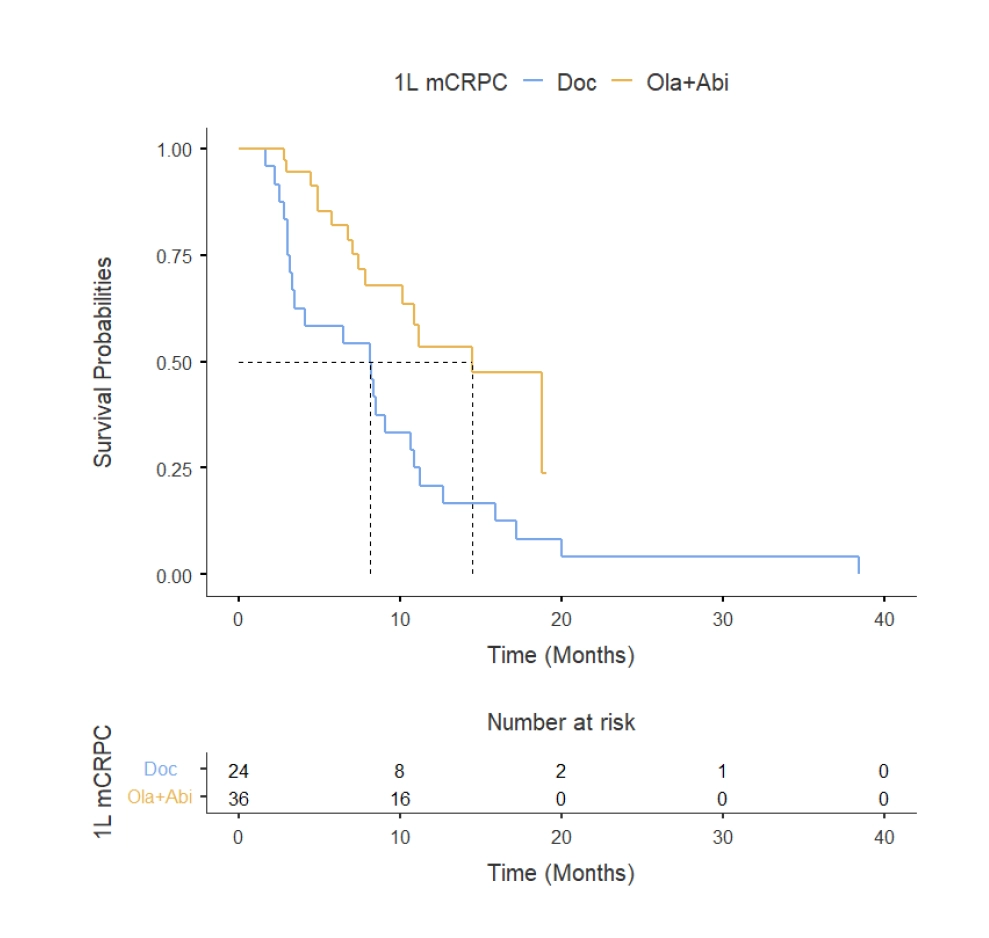Abstract Code: IUC24433-81
Docetaxel versus olaparib plus abiraterone as first-line treatment in patients with mCRPC: a retrospective single-centre analysis
M. Maffezzoli 1, L. Pedapati 1, M. Hassan 1, S.A. Sandulache 1, J. Samuel 1, F. Di Costanzo 2, G. Neola 3, J. Lau 1, A. Maniam 1, G. Banna 1
(1) Portsmouth University Hospitals NHS Trust, Portsmouth – United Kingdom, (2) The Newcastle Upon Tyne Hospitals NHS Foundation Trust, Newcastle – United Kingdom, (3) Federico II University, Naples – Italy
Background: Olaparib and abiraterone (Ola+Abi) has emerged as a novel first-line (1L) treatment option for metastatic castration-resistant prostate cancer (mCRPC), but comparisons with docetaxel are lacking. We retrospectively evaluated outcomes of patients treated with either docetaxel (Doc) or Ola+Abi as 1L therapy for mCRPC.
Methods: This real-world study included patients with mCRPC who received 1L treatment with either Doc or Ola+Abi. Radiographic progression-free survival (rPFS) was assessed using Kaplan-Meier estimates and compared by log-rank test.
Results: 60 patients were included: 24 (40%) received Doc and 36 (60%) received Ola+Abi. In the hormone-sensitive (HS) setting, 28 patients (77.8%) in the Ola+Abi group had received Doc, while in the Doc group, 12 patients (50%) had received ADT, 11 (45.8%) enzalutamide and 1 (4.2%) apalutamide. Baseline characteristics were well balanced except for the previous HS disease setting (p=0.015), although time to castration resistance was not significantly different (p=0.159), Table.
Median rPFS was significantly longer with the Ola+Abi group (14.5 months, 95%CI 10.2–NR) compared to Doc (8.2 months, 95%CI 3.5–10.9), p=0.004, Figure.
Conclusions: Ola+Abi was associated with improved rPFS compared to Doc as 1L treatment for mCRPC. Despite limitations due to retrospective design, small sample size, and possible differences in characteristics between the two groups, these results suggest different clinical outcomes between treatment strategies, which warrant overall survival data.
Table. Summary of baseline characteristics
| Doc (N=24) | Ola+Abi (N=36) | Total (N=60) | p value | |
| ECOG PS | 0.129 | |||
| 0 | 12.0 (50.0%) | 25.0 (69.4%) | 37.0 (61.7%) | |
| 1 | 12.0 (50.0%) | 11.0 (30.6%) | 23.0 (38.3%) | |
| Age | 0.617 | |||
| Mean (SD) | 70.5 (9.3) | 69.4 (8.1) | 69.8 (8.5) | |
| PSA at diagnosis | 0.777 | |||
| Mean (SD) | 280.0 (555.9) | 240.3 (513.1) | 256.2 (526.3) | |
| Hormone-sensitive setting | 0.015 | |||
| De novo LV | 5.0 (20.8%) | 11.0 (30.6%) | 16.0 (26.7%) | |
| De novo HV | 9.0 (37.5%) | 12.0 (33.3%) | 21.0 (35.0%) | |
| Metachronous LV | 0.0 (0.0%) | 9.0 (25.0%) | 9.0 (15.0%) | |
| Metachronous HV | 2.0 (8.3%) | 1.0 (2.8%) | 3.0 (5.0%) | |
| Non-metastatic | 8.0 (33.3%) | 3.0 (8.3%) | 11.0 (18.3%) | |
| Time to castration resistant | 0.159 | |||
| Mean (SD) | 21.0 (14.3) | 27.4 (18.7) | 24.9 (17.3) | |
| Range | 5.5 – 63.0 | 3.2 – 88.6 | 3.2 – 88.6 |
Figure 1. Kaplan-Meier curve for rPFS

